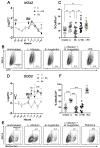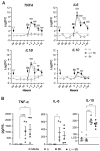Modulation of Macrophage Redox and Apoptotic Processes to Leishmania infantum during Coinfection with the Tick-Borne Bacteria Borrelia burgdorferi
- PMID: 37764937
- PMCID: PMC10537792
- DOI: 10.3390/pathogens12091128
Modulation of Macrophage Redox and Apoptotic Processes to Leishmania infantum during Coinfection with the Tick-Borne Bacteria Borrelia burgdorferi
Abstract
Canine leishmaniosis (CanL) is a zoonotic disease caused by protozoan Leishmania infantum. Dogs with CanL are often coinfected with tick-borne bacterial pathogens, including Borrelia burgdorferi in the United States. These coinfections have been causally associated with hastened disease progression and mortality. However, the specific cellular mechanisms of how coinfections affect microbicidal responses against L. infantum are unknown. We hypothesized that B. burgdorferi coinfection impacts host macrophage effector functions, prompting L. infantum intracellular survival. In vitro experiments demonstrated that exposure to B. burgdorferi spirochetes significantly increased L. infantum parasite burden and pro-inflammatory responses in DH82 canine macrophage cells. Induction of cell death and generation of mitochondrial ROS were significantly decreased in coinfected DH82 cells compared to uninfected and L. infantum-infected cells. Ex vivo stimulation of PBMCs from L. infantum-seronegative and -seropositive subclinical dogs with spirochetes and/or total Leishmania antigens promoted limited induction of IFNγ. Coexposure significantly induced expression of pro-inflammatory cytokines and chemokines associated with Th17 differentiation and neutrophilic and monocytic recruitment in PBMCs from L. infantum-seropositive dogs. Excessive pro-inflammatory responses have previously been shown to cause CanL pathology. This work supports effective tick prevention and risk management of coinfections as critical strategies to prevent and control L. infantum progression in dogs.
Keywords: Lyme disease; apoptosis; canine leishmaniosis; coinfection; inflammation; progression.
Conflict of interest statement
The authors declare no conflict of interest.
Figures






Similar articles
-
Investigation of comorbidities in dogs with leishmaniosis due to Leishmania infantum.Vet Parasitol Reg Stud Reports. 2023 Apr;39:100844. doi: 10.1016/j.vprsr.2023.100844. Epub 2023 Feb 15. Vet Parasitol Reg Stud Reports. 2023. PMID: 36878629
-
Frequency of co-seropositivities for certain pathogens and their relationship with clinical and histopathological changes and parasite load in dogs infected with Leishmania infantum.PLoS One. 2021 Mar 11;16(3):e0247560. doi: 10.1371/journal.pone.0247560. eCollection 2021. PLoS One. 2021. PMID: 33705437 Free PMC article.
-
Feline leishmaniosis: Is the cat a small dog?Vet Parasitol. 2018 Feb 15;251:131-137. doi: 10.1016/j.vetpar.2018.01.012. Epub 2018 Feb 2. Vet Parasitol. 2018. PMID: 29426470 Free PMC article. Review.
-
Detection of Leishmania infantum DNA and antibodies against Anaplasma spp., Borrelia burgdorferi s.l. and Ehrlichia canis in a dog kennel in South-Central Romania.Acta Vet Scand. 2020 Aug 3;62(1):42. doi: 10.1186/s13028-020-00540-4. Acta Vet Scand. 2020. PMID: 32746875 Free PMC article.
-
Cutaneous immune mechanisms in canine leishmaniosis due to Leishmania infantum.Vet Immunol Immunopathol. 2015 Feb 15;163(3-4):94-102. doi: 10.1016/j.vetimm.2014.11.011. Epub 2014 Nov 20. Vet Immunol Immunopathol. 2015. PMID: 25555497 Review.
Cited by
-
Borrelia, Leishmania, and Babesia: An Emerging Triad of Vector-Borne Co-Infections?Pathogens. 2025 Jan 6;14(1):36. doi: 10.3390/pathogens14010036. Pathogens. 2025. PMID: 39860997 Free PMC article.
-
Mitochondrial Reactive Oxygen Species in Infection and Immunity.Biomolecules. 2024 Jun 8;14(6):670. doi: 10.3390/biom14060670. Biomolecules. 2024. PMID: 38927073 Free PMC article. Review.
References
Grants and funding
LinkOut - more resources
Full Text Sources

